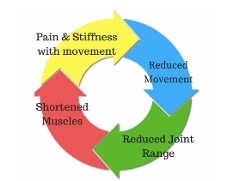
Have you noticed that some joints feel stiff, even if they’re not painful? Joint stiffness can make everyday activities harder and may be a sign that the joint is becoming less mobile or more vulnerable to injury. There are several possible causes of stiffness, and identifying the exact reason often requires a professional assessment. Here are some common contributors:
1. Inactivity and Lack of Movement
When joints aren’t moved through their full range regularly, they can start to feel restricted. This happens because the joint capsule may tighten, and the surrounding muscles can lose flexibility.
Regular movement helps to maintain joint mobility and muscle flexibility. Gentle stretching and range-of-motion exercises can go a long way toward preventing stiffness.
2. Osteoarthritis (OA)
Osteoarthritis is a degenerative condition that affects the cartilage covering the joint surfaces. Over time, this cartilage wears down, and bony growths may develop. While OA becomes more common with age, it’s often caused by abnormal stress on the joint rather than ageing alone.
OA-related stiffness is often most noticeable after periods of rest—like first thing in the morning—and usually improves after 15–20 minutes of gentle movement. Physiotherapy can help manage OA by strengthening muscles around the joint to reduce stress on the joint surfaces.
3. Inflammation
Swelling due to inflammation can limit movement and create a stiff sensation. This can happen after an injury, such as a sprain, or from conditions that cause the immune system to attack healthy tissue.
In both cases, inflammation narrows the space within the joint, making it feel stiff or stuck. Treating the inflammation and restoring mobility is key to recovery.
When to Seek Help
If you’re experiencing ongoing stiffness—especially if it’s limiting your movement or daily activities—it’s a good idea to get it checked. A physiotherapist can assess your joints and develop a tailored plan to help restore flexibility and prevent future issues.
Staying active and moving well is essential for joint health. If you’re unsure where to start, we’re here to help.
